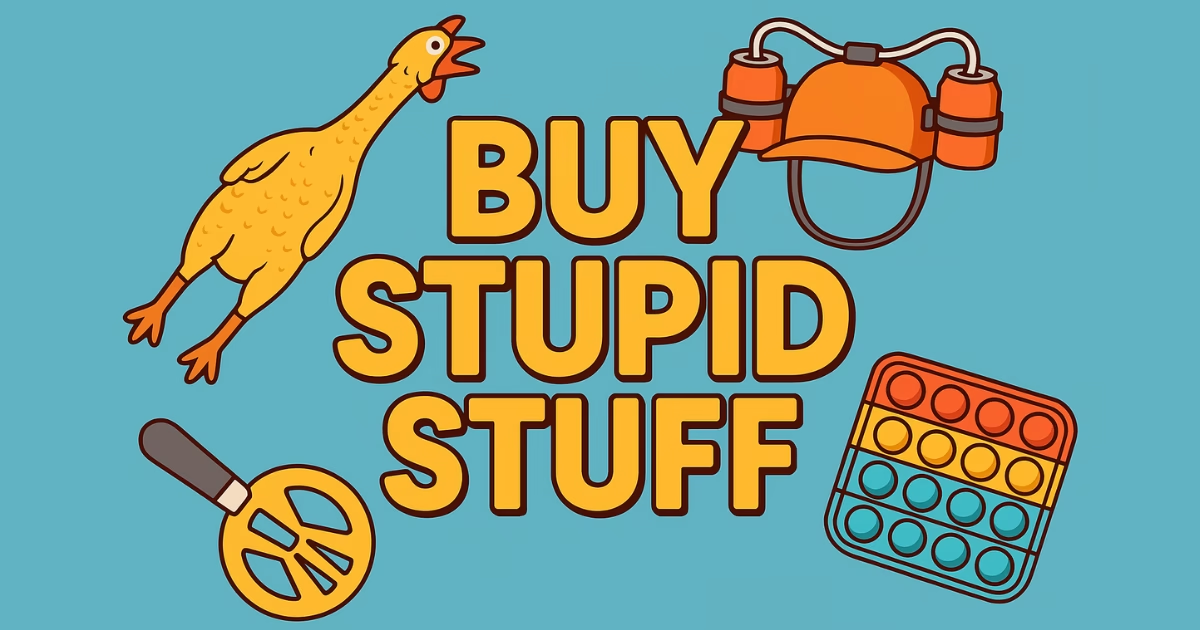In today’s consumer-driven world, the phrase “buy stupid stuff” has become a common part of modern shopping culture. From quirky gadgets to novelty items, many people find themselves drawn to purchasing things they don’t really need. These seemingly pointless purchases often bring a temporary sense of joy or satisfaction, especially when they are unique or amusing. Whether it’s an inflatable pool toy shaped like a unicorn or a banana slicer, the appeal of these products is undeniable. But what is it about buying stupid stuff that makes it so tempting? Is it the thrill of acquiring something unusual, or is it driven by emotional impulses and social trends? In this article, we’ll dive into the psychology behind why people love buying unnecessary items and the surprising reasons behind these purchases.
What Does “Buy Stupid Stuff” Really Mean?
The phrase “buy stupid stuff” refers to purchases that serve no practical purpose or are made impulsively, often based on novelty or humor. These items might seem ridiculous or unnecessary at first glance, but they frequently capture the attention of shoppers, leading them to click “buy now” without much thought. Examples include products like a selfie toaster that burns your face onto bread, quirky phone cases that are more about style than function, or inflatable lawn decorations.
What makes these items fall under the category of “stupid” is their lack of usefulness. They don’t improve daily life, and more often than not, they end up collecting dust after a few uses. Yet, despite their impracticality, buying stupid stuff has become a staple of modern consumerism. It’s driven by novelty, fun, or the desire to make a statement—sometimes even when those reasons are fleeting.
The Psychology Behind Buying Stupid Stuff
At the core of buying stupid stuff lies a complex psychological phenomenon. Impulse buying, a key factor, often leads shoppers to make unnecessary purchases without prior planning. This behavior is triggered by emotions like excitement, curiosity, or the desire to experience something new. The instant gratification of purchasing something unique or funny provides a sense of joy, even if that feeling doesn’t last long.
Another psychological aspect is the dopamine rush associated with buying things. When we make a purchase, our brains release dopamine, the “feel-good” neurotransmitter. This chemical reaction can feel rewarding, which explains why people sometimes find themselves buying things that, in retrospect, seem pointless. Furthermore, the desire for social validation plays a role. Seeing a quirky item go viral on social media or seeing friends share their latest purchases can prompt others to buy similar things to fit in or make a statement.
The key takeaway here is that people don’t always make purchases based on need. Instead, they often buy stupid stuff because it fulfills an emotional or psychological desire.
The Impact of Buying Stupid Stuff
While buying stupid stuff may bring immediate pleasure, it often has a long-term impact that can be less than positive. Emotional satisfaction is the first reward we feel after making a purchase, especially when we’re drawn to an item because it’s unique, fun, or amusing. But this satisfaction tends to fade quickly, leaving behind a feeling of regret or disappointment. How often do we purchase something on impulse, only to have it sit unused in the back of a drawer?
Financially, buying unnecessary items can add up over time. Small, impulse purchases may not seem like a big deal in the moment, but they can lead to larger consequences when accumulated. For example, someone who frequently buys novelty items may find themselves spending a substantial amount of money on things that provide no lasting value. The clutter created by these purchases can also negatively impact a person’s space, creating unnecessary stress.
The key is to recognize that while fun, these purchases often fail to deliver any true lasting benefit.
Social Media and Advertising Fueling Stupid Purchases
Social media and advertisements are prime drivers of buying stupid stuff. Viral trends, influencer endorsements, and targeted ads have made it easier than ever for quirky, unusual, and sometimes utterly pointless products to become must-have items. From videos showcasing bizarre gadgets on Instagram to viral TikToks featuring “life-changing” products, it’s no wonder that shoppers are often drawn into the frenzy.
The constant bombardment of ads and posts featuring these items creates a fear of missing out, or FOMO, that pushes people to make impulsive purchases. Influencers, in particular, play a massive role in fueling the demand for novelty items. Whether it’s an influencer showing off a bizarre kitchen gadget or a meme circulating about a hilarious product, people often feel the urge to join in on the fun and buy these items themselves.
As a result, products that seem frivolous or unnecessary quickly gain popularity, often driven by social media culture and persuasive advertising.
Are We Addicted to Buying Stupid Stuff?
It’s easy to dismiss buying stupid stuff as a harmless habit, but for some people, it can become an addiction. The addictive nature of shopping is something that has become more prominent with the rise of e-commerce and social media. The ease of online shopping allows consumers to make impulse buys at any time of day, and the constant availability of new, quirky products only fuels this behavior.
The act of shopping often provides a temporary escape from stress or emotional discomfort. Known as retail therapy, buying unnecessary items can feel like a quick fix for anxiety or boredom. The problem arises when this behavior becomes habitual, leading to a cycle of buying without truly thinking about the consequences.
While it may seem innocent at first, over time, it can contribute to financial strain and emotional dissatisfaction. Recognizing when shopping is becoming an emotional crutch is key to breaking the cycle of buying stupid stuff.
How to Avoid Wasting Money on Stupid Stuff
Breaking the habit of buying stupid stuff starts with becoming more mindful of our purchases. One simple way to avoid wasting money is by creating a shopping list and sticking to it. By knowing exactly what you need, you can avoid being swayed by impulse purchases that don’t serve a practical purpose.
Another effective strategy is to practice delayed gratification. Instead of purchasing an item immediately, wait for 24 to 48 hours before deciding whether it’s truly necessary. Often, the desire to buy something fades after a short period of reflection.
Additionally, setting a budget and limiting your spending on unnecessary items can help curb impulsive shopping. When making online purchases, avoid scrolling through “suggested” items or engaging with ads that target you specifically. The more intentional you are with your spending, the less likely you’ll be to fall into the trap of buying stupid stuff.
Funniest Examples of Stupid Stuff People Buy
While it’s easy to dismiss some purchases as wasteful, many people find joy in these quirky and bizarre items. Some of the funniest examples of stupid stuff include:
- A selfie toaster that brands your face onto slices of bread.
- Mop slippers that allow you to clean your floor while walking.
- A potato gun that shoots spuds instead of traditional ammunition.
- A glow-in-the-dark toilet paper for the ultimate bathroom experience.
- Shark-shaped vacuum cleaners that are as cute as they are impractical.
These items, though silly, often bring laughter and entertainment, even if they don’t add much value to daily life. For some, buying stupid stuff is all about the fun and novelty of owning something strange or humorous.
The Good Side of Buying Stupid Stuff
Despite the apparent wastefulness, there’s actually a good side to buying stupid stuff. Sometimes, these items serve as conversation starters, gifts, or simply sources of joy. A quirky product can brighten your day or become an inside joke among friends.
For example, novelty items like a quirky mug or a funny T-shirt can bring lightheartedness to someone’s life. Gifts that seem absurd at first may be appreciated for their humor or creativity, especially when they cater to a person’s specific tastes. Even though these items might not serve a functional purpose, they can still create memorable moments and bring a smile to someone’s face.
In this way, buying stupid stuff isn’t always entirely negative—it can contribute to moments of joy, connection, and even humor.
Also Read: Best High-End Things to Buy in Japan: Luxury Must-Haves
Conclusion: Is It Time to Stop Buying Stupid Stuff?
Ultimately, the question remains: Is it time to stop buying stupid stuff? While these purchases can bring instant gratification and laughter, they often don’t provide lasting value. The challenge is finding a balance between indulging in fun, novelty items and being mindful of how those purchases affect your wallet and your space.
By practicing mindful shopping, setting limits, and recognizing impulse buying habits, it’s possible to enjoy the occasional quirky purchase without letting it become a costly habit. Remember, it’s okay to buy something silly or unnecessary from time to time, but it’s also important to evaluate whether the joy it brings is worth the cost.
As we reflect on the trend of buying stupid stuff, it’s clear that these purchases are here to stay. But, next time you’re tempted to grab something for the laugh, pause and ask yourself: Is this really worth it?

Hi, I’m Shafy Ali – a curious mind and passionate writer at Celiac Magazine. I cover a little bit of everything, from everyday tips and how-tos to deeper dives into topics that spark conversation. I enjoy turning research into readable, relatable content that informs and inspires. Whatever the subject, I aim to keep it clear, engaging, and genuinely useful.

